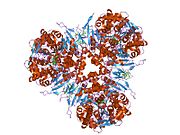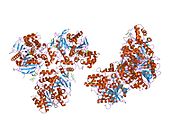
Monoacylglycerol lipase is an enzyme that, in humans, is encoded by the MGLL gene. MAGL is a 33-kDa, membrane-associated member of the serine hydrolase superfamily and contains the classical GXSXG consensus sequence common to most serine hydrolases. The catalytic triad has been identified as Ser122, His269, and Asp239.

Bile salt-dependent lipase, also known as carboxyl ester lipase is an enzyme produced by the adult pancreas and aids in the digestion of fats. Bile salt-stimulated lipase is an equivalent enzyme found within breast milk. BSDL has been found in the pancreatic secretions of all species in which it has been looked for. BSSL, originally discovered in the milk of humans and various other primates, has since been found in the milk of many animals including dogs, cats, rats, and rabbits.
The enzyme acetylsalicylate deacetylase (EC 3.1.1.55) catalyzes the reaction
The enzyme carboxylesterase (or carboxylic-ester hydrolase, EC 3.1.1.1; systematic name carboxylic-ester hydrolase) catalyzes reactions of the following form:

In enzymology, an agmatinase (EC 3.5.3.11) is an enzyme that catalyzes the chemical reaction

Carboxylesterase, type B is a family of evolutionarily related proteins.

UDP-glucuronosyltransferase 1-10 is an enzyme that in humans is encoded by the UGT1A10 gene.

Estrogen sulfotransferase is an enzyme that in humans is encoded by the SULT1E1 gene.

UDP-glucuronosyltransferase 2B15 is an enzyme that in humans is encoded by the UGT2B15 gene.

Meprin A subunit alpha also known as endopeptidase-2 or PABA peptide hydrolase is the alpha subunit of the meprin A enzyme that in humans is encoded by the MEP1A gene. The MEP1A locus is on chromosome 6p in humans and on chromosome 17 in mice.

Carboxylesterase 2 is an enzyme that in humans is encoded by the CES2 gene. It is a member of the alpha/beta fold hydrolase family.

Dimethylaniline monooxygenase [N-oxide-forming] 1 is an enzyme that in humans is encoded by the FMO1 gene.

UDP-glucuronosyltransferase 1-4 is an enzyme that in humans is encoded by the UGT1A4 gene.

UDP glucuronosyltransferase 2 family, polypeptide B4, also known as UGT2B4, is an enzyme that in humans is encoded by the UGT2B4 gene.

Dimethylaniline monooxygenase [N-oxide-forming] 5 is an enzyme that in humans is encoded by the FMO5 gene.

Dimethylaniline monooxygenase [N-oxide-forming] 2 is an enzyme that in humans is encoded by the FMO2 gene.

Cytochrome P450 2A13 is a protein that in humans is encoded by the CYP2A13 gene.

Carboxylesterase 3 is an enzyme that in humans is encoded by the CES3 gene.

The enzyme Triacylglycerol lipase (also Triglyceride lipase, EC 3.1.1.3;systematic name triacylglycerol acylhydrolase) catalyses the hydrolysis of ester linkages of triglycerides:
The enzyme pyrethroid hydrolase (EC 3.1.1.88, pyrethroid-hydrolyzing carboxylesterase, pyrethroid-hydrolysing esterase, pyrethroid-hydrolyzing esterase, pyrethroid-selective esterase, pyrethroid-cleaving enzyme, permethrinase, PytH, EstP; systematic name pyrethroid-ester hydrolase) catalyses the reaction































